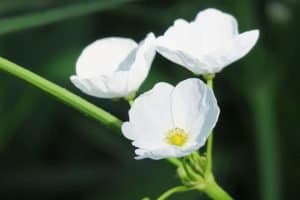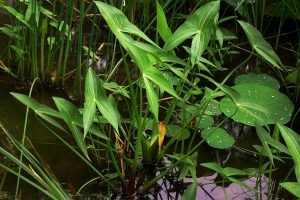What is an Arrowhead plant?
The scientific name of an Arrowhead plant is Syngonium podophyllum, which is from Araceae family. Some of its common names are arrowhead vine, five fingers, American evergreen, and nephthytis. An Arrowhead plant is a perennial plant that is native to South America. They are easy to care for as a houseplant.

As the name suggests, it has arrow-shaped, long-lobed, and divided leaves. The Arrowhead plant has a distinctive blade. When the plant matures, the edge changes from arrow-shaped to a five-lobed form. The five-lobed shape of the leaf represents the five elements: water, earth, fire, wood, and metal. Each leaf is of size ranging from 1.5 dm to 6 dm long. Some of the flowers are white, pink, or yellow. When the plant is matured, its flower blooms more outdoors, in its natural habitat. The flowers bloom in the set of three long white petals on the central stem from July to September. Its root is white and thin.
This plant grows up to 6 feet indoors, and much high when planted outdoors. The plant should be repotted in every second spring because of its spreading root structure. Arrowhead plants are rich in nutrients such as protein, carbohydrate, fiber, Vitamin C, calcium, magnesium, potassium, iron, and sodium.
Scientific classification of an Arrowhead plant
Kingdom: Plantae
Order: Alismatales
Family: Araceae
Genus: Syngonium
Species: S. podophyllum
Types of Arrowhead plant
There are over 30 species of Arrowhead plants. The plants are of different sizes and have different colored leaves. There are only two varieties of Arrowhead plants that grow in the wild: Syngonium Podophyllum and Syngonium Peliocadum.
Some common types of Arrowhead plant are:-
Berry Allusion
It is also known as Berry Allusion Nephthytis. It is grown quickly, and they have light green leaves with shades of pink and cream.
Bold Allusion
It is also known as Bold Allusion Nephthytis. It is a beautiful and slow-growing variety of Arrowhead. It has creamy-green leaves with pink veins.
Cream Allusion
It is also known as Cream Allusion Nephthytis. It is one of the compact variety having medium-sized leaves. The leaves are creamy-green and saturated with pink color.
Exotic Allusion
It is also known as Exotic Allusion Nephthytis. This variety of Arrowhead has light green leaves having creamy white color in the blade.
Holly
It is also known as Holly Nephthytis. This variety has white leaves having some green edges and veins.
Julia Allusion
It is also known as Julia Allusion Nephthytis. This compact variety of Arrowhead plant has a light green leaf which is flushed with coppery pink color.
Maria Allusion
It is also known as Maria Allusion Nephthytis. This new variety has light green leaves. The leaves are shaded and filled with coppery pink color.
Painted Arrow
It is also known as Painted Arrow Nephthytis. This variety is a lovely one, and it has creamy-green leaves covered with light green spots.
Pink Allusion
It is also known as Pink Allusion Nephthytis. It has light green leaves with pink veins, and its edge has a dark green color.
Strawberry Cream
It is also known as Strawberry Cream Arrowhead Vine. This variety has a unique leaf growth. When it is kept in bright light, then the leaf color turns out to be the best one.
White Butterfly
It is also known as White Butterfly Arrowhead Vine. It is one of the most popular varieties having greenish-white leaves. The edges of the leaf are dark green.
How to grow an Arrowhead plant?
Arrowhead plants can also be grown outdoors, but it is typically a houseplant, which grows indoor. It can be planted alone or along with other plants. You should propagate this plant in low or medium light. While growing indoors, you can grow best in a hanging basket.
How to grow an Arrowhead plant in a pot?
An arrowhead plant is propagated using plant division or by stem cuttings. Stem cuttings are the more natural method to propagate the plant. Some of the Arrowhead has aerial roots growing on the stem, so take a cutting from the stem having aerial roots for a high success rate. Steps for planting an Arrowhead plant is:
- First of all, make soil mix, 60%gardening soil, 20% fine sand, and 20% vermicompost.
- Take a pot and fill it with potting mix.
- With the help of scissors or cutter, cut the stem of the plant.
- In the pot, plant the cutting and water it.
- After 10 to 15 days, you will see the growth of the plant having well-developed roots.
How to grow Arrowhead Plant in the water?

- First of all, cut one leaf with its root, but remove excess one.
- Take a transparent glass full of water and add some pebbles and chips at the bottom of the glass.
- Add the cuttings to sea, and keep it in the right light area.
- After some days, you will see growth in the plant.
Here is a video on how to propagate the Arrowhead Plant in water.
How to care for an Arrowhead plant?
You should care for the Arrowhead plant properly. Some of the tips to care for the Arrowhead plan are listed below:
- Avoid direct sunlight for this houseplant.
- Moisture is required, but watering the plant frequently leads to root rot, so you should allow the plant to dry out in between watering it.
- The temperature of 60 ºF to 80 ºF needs to be maintained all year. Heat below 50 ºF can kill the plant.
- This plant prefers high humidity.
- Fertilize the plant every two weeks in the summer and spring.
- Arrowhead plant grows well in acidic, fertile soil having pH 5.5 to 7.
- Avoid leaf scorching if you are growing the arrowhead plant outdoors.
Possible side effects of Arrowhead plant
- It causes skin irritation when in contact for a long time, so wear gardening gloves while handling the Arrowhead plant.
- Arrowhead vine is toxic to cats and dogs.
- It may cause hemorrhoids and diarrhea.
Where can I buy Arrowhead Plant?
You can find this amazing plant for sale in your local nurseries as well as contact your local florist too.

Amelia is a plant and nature lover! Ever since she was little, she loved spending time in her family’s garden and learning about how to care for each plant individually. As an adult, she has dedicated herself to sharing what she has learned and continuing to expand her knowledge on the plant kingdom.

